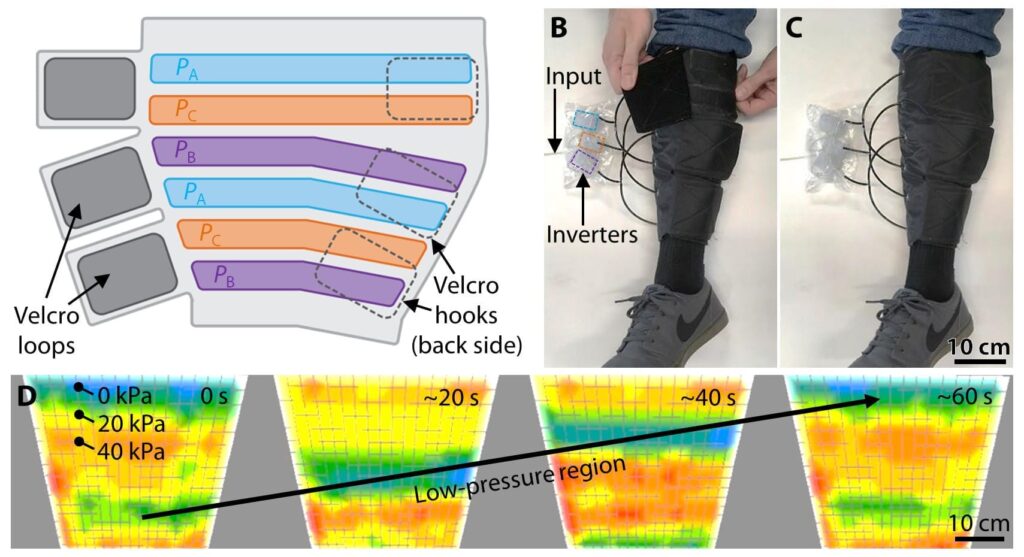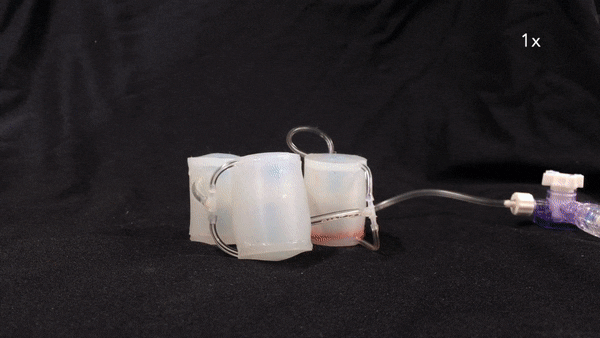
A soft ring oscillator gives soft robots new movements without the hard parts
Soft robots can’t always compete with the hard. Their rigid brethren dominate assembly lines, perform backflips, dance to Bruno Mars’ “Uptown Funk,” fly, dive, and walk through volcanoes.
But each year, soft robots gain new abilities. They’ve learned to jump, squirm, and grip. And, unlike hard robots, they can handle tomatoes without bruising the fruit, resurface unscathed after being run over by a car, and journey through radiation, disaster zones, and outer-space with few scars. For people and animals, they have a “cooperative function”: a soft touch.

Recently, researchers in the lab of George M. Whitesides, the Woodford L. and Ann A. Flowers University Professor, have invented soft replacements for the last hard parts required to build a robot. Instead of electricity and wires, pressurized air expands and contracts rubber inflatables to create movement, soft valves take over for the hard, and soft digital logic replicates the same capabilities of an electronic computer.
Now, postdoctoral scholar Daniel J. Preston’s latest soft invention gives these robots new, complex movements. As first author on a study published in Science Robotics, he introduces the first soft ring oscillator, which gives soft robots the ability to roll, undulate, sort, meter liquids, and swallow.
“It’s another tool in the toolkit to make these smart, soft robots without any electronics, and without any hard valves,” Preston says.
Until now, ring oscillators were made with electronic transistors or microfluidics. Electronics always require hard components. Most microfluidics do, too. Many use glass for their pressurized water or air systems and require thin channels that can only handle very low flow rates, limiting operation speeds. Tiny microfluidic systems might achieve higher frequencies than Preston’s macroscale pneumatic ring oscillator, but his team already has blueprints to tweak their soft system to achieve greater speeds, if needed.
The soft ring oscillator—like all ring oscillators—relies on inverters (“NOT” digital logic gates). Preston’s inverters, for example, manipulate the air pressure in his robot’s rubber tubes: If the input is high pressure, the output will be low pressure and vice versa. When three, or any odd number, of gates are connected in a ring, one gate’s shift triggers the next, which triggers the next, and on and on.
“The cool response that you get when you combine an odd number of these inverters in a loop is an instability that travels around the loop,” Preston says. Like a slinky that collapses in order to spring down a flight of stairs, one movement sparks the next, creating a constant pace without the need for another push.
To test what the soft ring oscillator could do, Preston and his team created five soft robot prototypes. Each uses a single, constant source of air pressure to run three pneumatic actuators (the inverters).
One prototype nudges a ball around a ring. Another undulates a stage to keep beads of two different sizes rolling against the edge. Eventually, all the smaller beads fall through a hole in the side of the stage. They sort themselves out.
Before they start clinical trials for their sleeve, the team wants to gauge interest. If enough people crave a softer, less expensive way to alleviate and prevent symptoms, the product might just find a big enough market to merit further research.
The low cost of Preston’s materials—rubber-like silicone elastomers—makes them ideal for more than just inexpensive homecare. Biocompatible, disposable, gentle, and sterile versions could be used for lab experiments, drug delivery, or even medical devices inside the body like this sleeve that helps the heart beat. Preston’s final prototype can sort three different colored liquids based on a pre-determined sequence and time, a tool that could prove useful for chemists.
Though all of Preston’s prototypes are made with only soft materials, they’re not yet untethered: All rely on a constant source of pressurized air. Yet Preston and his colleagues have a few solutions for this, too. For the leg sleeve, patients could provide their own air with a hand-held pump like those used to take blood pressure. And soft robots in the trenches could use mobile carbon dioxide cartridges, strapped on like a backpack, or gas-generating chemical reactions to set the bot in motion.
But Preston expects his new tool to achieve far more than the applications demonstrated in his five prototypes. Since the paper explains how to replicate and customize the design, he hopes other labs will find even more uses. “People can use the soft ring oscillator for a lot of different applications in soft robotics, some of which we may not have even thought of or envisioned yet.”
Learn and see more: Soft robots for all
The Latest on: Soft robotics
[google_news title=”” keyword=”soft robotics” num_posts=”10″ blurb_length=”0″ show_thumb=”left”]
via Google News
The Latest on: Soft robotics
- Dyson just launched a robot vacuum — snag one before they sell outon April 29, 2024 at 9:41 am
As a lover and major tester of vacuums, I’m beyond excited about the launch of Dyson’s latest robot vacuum with a host of new technology. Dyson claims this is “the most powerful robot with twice the ...
- CMU Researchers, Robots Head To Nation’s Capital for Robotics Showcaseon April 29, 2024 at 8:21 am
Carnegie Mellon University researchers from its Robotics Institute and College of Engineering are packing up fossil-inspired paleobionics, robotic hands and autonomous aerial vehicles to demonstrate ...
- A touch of genius. How to make soft and squishy robotson April 28, 2024 at 4:14 am
The major challenge to robots becoming more human-like is the skin and the sense of touch, and responses to it. The complexity of design in creating human-like skin for robots is enormous: ...
- Soft robotic nerve cuffs could revolutionize treatment of neurological conditionson April 26, 2024 at 5:49 pm
Researchers have developed tiny, flexible devices that can wrap around individual nerve fibres without damaging them.
- Video of super-fast, super-smooth humanoid robot will drop your jawon April 26, 2024 at 3:51 am
While it seems that another humanoid robot is being released every week, we've yet to see one move as quickly or with as much precision as the model just released by Chinese company, Astribot. We dare ...
- Underwater robot pioneers new energy-efficient buoyancy controlon April 25, 2024 at 11:17 am
A remotely operated underwater robot built by a team of Rice University engineering students pioneers a new way to control buoyancy via water-splitting fuel cells. The device, designed and constructed ...
- This robot can predict a smile before it happenson April 24, 2024 at 11:17 am
STORY: This AI-integrated robotic face can predict a smile before it happens.It's called Emo and it can anticipate and mimic human facial expressions.Engineers at Columbia University’s Creative ...
- 3D Printed Soft Skin Pads Offer Enhanced Safety and Usability in Roboticson April 23, 2024 at 9:00 am
Researchers at the University of Illinois have leveraged 3D printing to develop soft skin pads to enhance safety and usability in robotics.
- How 3D printers can give robots a soft touchon April 17, 2024 at 2:36 pm
Soft skin coverings and touch sensors have emerged as a promising feature for robots that are both safer and more intuitive for human interaction, but they are expensive and difficult to make. A ...
- This robot vacuum is a steal at $450 thanks to an Amazon discounton April 17, 2024 at 8:08 am
The Eufy X8 Pro is 31% off right now on Amazon, and if you have a lot of carpet in your home, this is a must-have robot vacuum.
via Bing News











